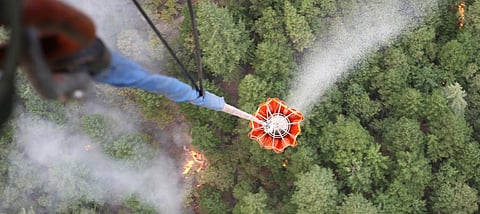A wildfire recovery guide for California
While the world’s attention is focused on the burning of the Amazon, the American state of California is still reeling from the wildfires of 2018, the most severe and deadliest-ever for the state.
To help Californians cope with the aftermath of these fires and to adequately prepare for future fires, the California Native Plant Society (CNPS) has just released a statewide fire recovery guide.
A collaborative effort among CNPS, scientific experts, and 30 state and local agencies, the guide is intended to serve as a primer for both fire safety and what to do and, more importantly, what not to do once fire has scorched an eco-region.
The guide is an expanded and updated version of a fire recovery guide CNPS published for the California wine growing counties after fires destroyed much of that area in 2017. The guide is available through participating organisations and agencies, or it can be downloaded from the CNPS website.
The 92-page booklet is intended for property owners and land managers who may be tasked with post fire clean-up or fire resilience measures. Liv O’Keeffe, Marketing and Communications Director for CNPS, says that response to the publication has been quite positive.
“People are hungry for information and assistance, and our partners are spread thin, working all over the state to provide information,” she says. “These guides cover a lot of that information in one place, so it gives them a helpful resource to hand out or point people to. Local CNPS chapters have also been an important local resource and are working with their communities to help get this in people's hands.”
California green
California is about the size of Italy and comprises diverse bioregions, from temperate rainforests to deserts. The guide focuses on a dozen of these bioregions, all of which, over eons, have adapted to fire.
Many trees native to California have fire-resistant bark. Some plants re-sprout from underground burls after being consumed by fire. For others, their seeds are germinated by being exposed to the heat or smoke from a wildfire.
Native annuals will build up seed banks in the soils for 50 or 60 years waiting for the heat or smoke from a fire to trigger germination.
What comes to mind when people think of California, are the mixed evergreen forests that contain the California sequoias. Historically, these forests have experienced low-intensity ground fires that recur approximately every 25 years. With fire-resistant bark, the trees, such as ponderosa pine and the sequoias, are adapted to withstand these fires.
While the mature trees are unfazed by the low-intensity fires, the fires benefit the forests by clearing out brush and undergrowth. Fires burn up dead branches and other litter accumulated on the ground, which gives room for seeds to take root. Fire also begins the next phase of post-fire recovery, instigating the germination for many of the seeds of these trees.
Over the last century-and-a-half, fire suppression in California’s evergreen forests has allowed brush and litter to accumulate. With the buildup of flammable material, evergreen forest fires burn hotter and can reach the upper branches of the mature trees, killing them.
In the case of chaparral, the signature biome of California, fires that occur too frequently are the problem. Chaparral is adapted to a fire regime that recurs in 20 to 120 years.
With more and more roadways and houses built in the chaparral, however, there are more opportunities for human-induced ignition. If the fires repeat more often than every 15 years, sooner than the chaparral has a chance to mature, non-native annual grasses take over.
Forest or chaparral can be further harmed by improper recovery methods. “When we look at a burned landscape, our impulse may be to clean it up and replant it right away,” says O’Keeffe. “But we’ve got to be patient when it comes to natural and healthy land recovery. In fact, we can unknowingly do more harm than good without the right information.”
What not to do
Among the mistakes that well-intentioned individuals make in fire recovery is to remove charred remains. The trees that are charred and look dead may still be alive, sprouting new leaves in a few weeks or months.
The ash, burnt trunks, and other debris can actually hold soil and reduce problems of erosion after a fire. Dead trees can provide habitat for birds and other animals. Their roots stabilise soil.
Sowing seed mixes can introduce grasses that have shallow roots, dry out in summer, and become highly flammable. Even seed mixes designated as “native” may contain non-native, inappropriate, and even weedy species.
In many cases after a fire, the best thing to do is to do nothing. The guide encourages individuals to monitor for erosion, keep foot traffic to a minimum, and remove non-native and invasive species, all the while keeping soil disturbance to a minimum.
(Paul Hormick is a freelance writer and an environmental advocate in San Diego, California)
(Views expressed are the author's own and don't necessarily reflect those of Down To Earth)


